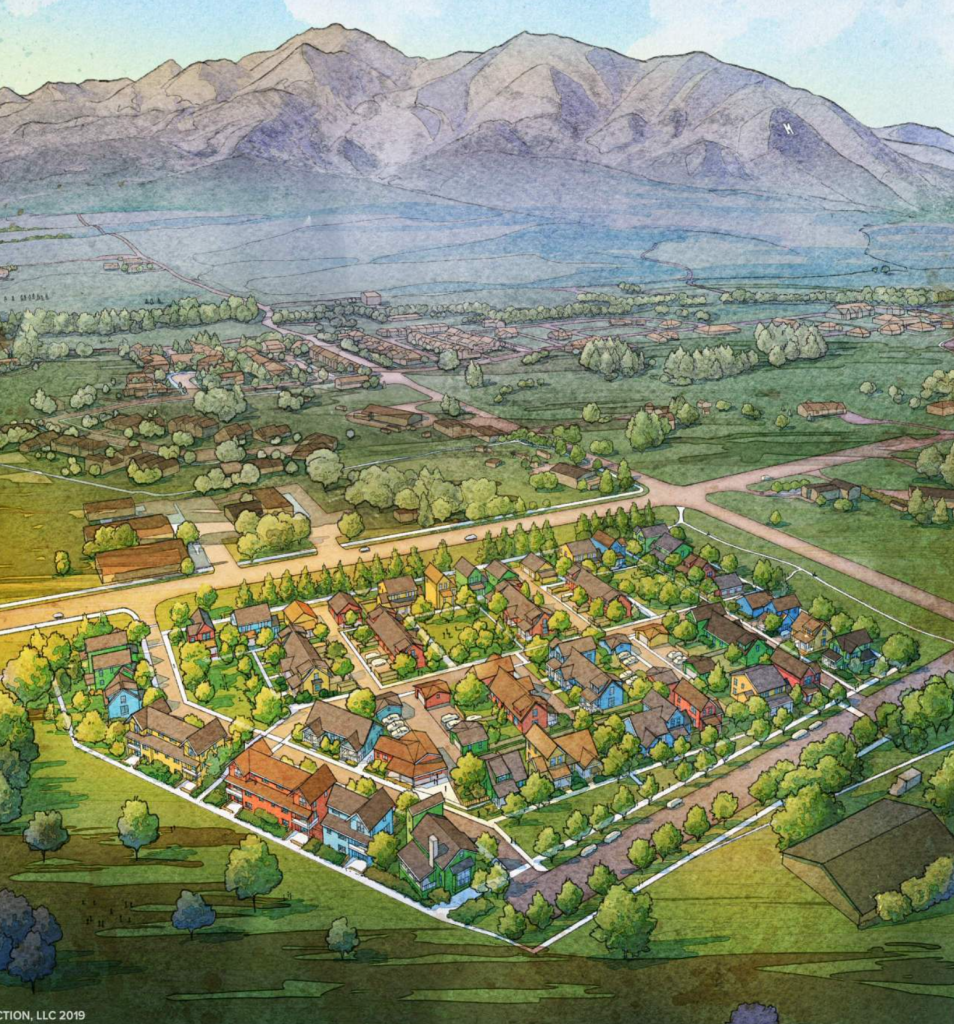Bozeman will never achieve its climate or affordability goals without updating its zoning code to allow small lots, small floor plans, and more shared walls.
Bozeman’s development code bans small lots. A ban on small lots is, effectively, a ban on affordable, sustainable and desirable missing middle housing.
The current Bridger View subdivision being developed by HRDC is a case in point. Bridger View will provide 62 new units of housing on 8 acres of land, mostly in the form of single-family houses. Half of these units will be affordable “missing middle” houses. To accomplish this miracle of affordability and compactness the lots sizes within Bridger View (averaging 2500 SF) will be approximately half the size of a typical single-family lot in Bozeman (5000 SF+) and floor plans will be substantially smaller (800 – 1500 SF) than typical new construction. The result will be the most affordable and sustainable neighborhood built in Bozeman in living memory.

Bridger View is only able to accomplish this by using a special provision in the City development code called a “Planned Unit Development” which allows relaxations in code requirements in exchange for better design. To become a reality, Bridger View requires waiver of nineteen sections of our zoning code, including at least four prohibiting small lots:
- Minimum lot size. The minimum lot size in Bozeman is 4000 SF. (Table 38.320.030.)
- Minimum lot width. All new lots must be 50’ wide (unless accessed by an alley, then 40’). (Table 38.320.030.B)
- Setbacks. Setbacks are the minimum distance between the lot line and the building. Per code, all lots must have a 15’ front setback, 5’ side setbacks, and a 20’ rear setback. The “required space for setbacks” formula is “Empty Space for Setbacks = 350 + 10L + 35W” where L is the length of the building envelope and W is its width. To build a 100 SF shack you would need an 800 SF lot. That works out to 100 SF of space for you and 700 SF for the planning department (Table 38.320.030.C). Of course, even without the 4000 SF lot size minimum, an 800 SF lot is impossible, since lots must be at least 50’ wide and have 20’ of empty space at their rear—1000 SF of empty space for the rear setback alone.
- Lot coverage. In addition to required setbacks, and a minimum lot size, city code also places a strict maximum on how much of the lot your house can cover. (Table 38.320.030.C) This is separate from the Floor Area Ratio (FAR) maximum that prescribes how many square feet of interior space you can have.
It’s not just the lot size minimums. The ban on small lots is also codified in our lot width minimums, required setbacks, lot coverage maximums, FAR maximums, block frontage requirements, street access requirements, off-street parking requirements, utility easements, and elsewhere. All of these different regulations do the exact same thing: they effectively prohibit small lots. This is redundant and counterproductive to the city’s affordability and sustainability goals.
We live in a city with an affordability crisis that bans small lots. Because land is expensive, a ban on small lots is effectively a ban on small houses (like many of those built in Bozeman in the 30’s, 40’s, and 50’s). Consistent with national trends, our average house size in ballooning, even as fewer existing Bozemanites are able to afford housing.
What justifies Bozeman’s ban on small lots? Why do we ban small lots but not large lots? Why do we prescribe lot sizes at all?
We live in a city that pays lip service to “sustainability” and yet over half of residential areas are zoned in a way that prohibits multiunit development or duplex conversions. Low density development fuels sprawl increasing our reliance of cars. Single-family detached houses are far less energy efficient than housing units that share walls. Obviously, many people prefer to live in a detached house that does not share walls, but why explicitly prohibit the occasional duplex or triplex across vast swaths of town?
In her book “The Five-Ton Life” (a profile of American communities that produce less than half of Bozeman’s per-capita greenhouse gas emissions) Susan Subak demonstrates conclusively that greenwashing with LED lights and solar panels does far less to reduce greenhouse gas emissions than reducing building sizes and sharing walls. Subak writes that tools such as
“technical improvements in building design and renewable energy … can be helpful, but they give incomplete guidance on the essential importance of smaller floor plans and lot sizes in general. More broadly, city and community governments have a role to play in expanding opportunities for smaller living spaces by changing zoning laws to allow for more compact development, multi-unit construction and single-house to multi-unit conversions.”
It’s time for city leaders to take tangible action:
- Eliminate lot size minimums (acknowledging that other code provisions such as setbacks and utility easements will ensure that lots remain adequately large).
- Reduce required front setbacks to 10’ and required rear setbacks to 5’.
- Waive lot coverage maximums for floorplans of up to 1500 SF.
- Modify our zoning code (based on the recent examples from Oregon and Minneapolis) to allow duplexes or triplexes in every neighborhood.
Are we serious about affordability and sustainability—or not? What could we possibly lose by allowing smaller lots and smaller houses?